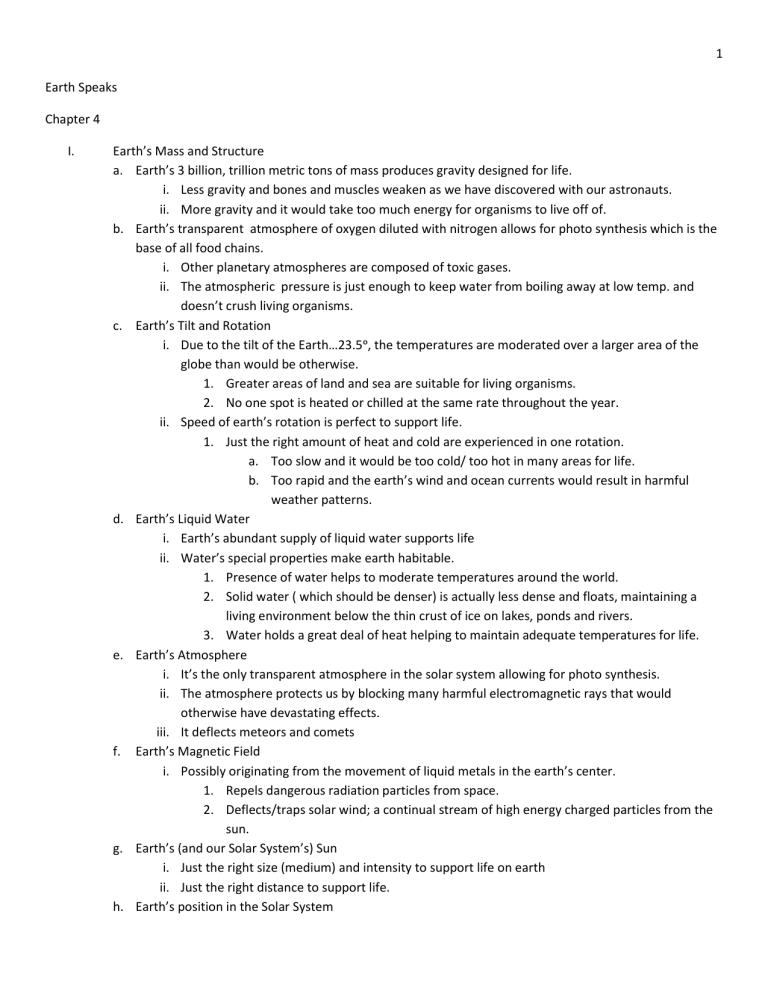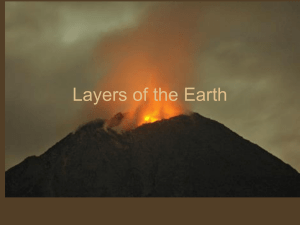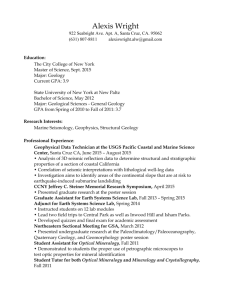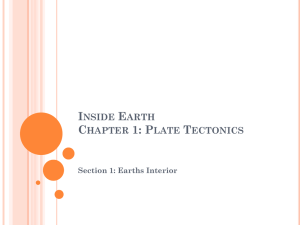chapter 4 outline

Earth Speaks
Chapter 4
I.
Earth’s Mass and Structure a.
Earth’s 3 billion, trillion metric tons of mass produces gravity designed for life. i.
Less gravity and bones and muscles weaken as we have discovered with our astronauts. ii.
More gravity and it would take too much energy for organisms to live off of. b.
Earth’s transparent atmosphere of oxygen diluted with nitrogen allows for photo synthesis which is the base of all food chains. i.
Other planetary atmospheres are composed of toxic gases. ii.
The atmospheric pressure is just enough to keep water from boiling away at low temp. and doesn’t crush living organisms. c.
Earth’s Tilt and Rotation i.
Due to the tilt of the Earth…23.5ᵒ, the temperatures are moderated over a larger area of the globe than would be otherwise.
1.
Greater areas of land and sea are suitable for living organisms.
2.
No one spot is heated or chilled at the same rate throughout the year. ii.
Speed of earth’s rotation is perfect to support life.
1.
Just the right amount of heat and cold are experienced in one rotation. a.
Too slow and it would be too cold/ too hot in many areas for life. b.
Too rapid and the earth’s wind and ocean currents would result in harmful weather patterns. d.
Earth’s Liquid Water i.
Earth’s abundant supply of liquid water supports life ii.
Water’s special properties make earth habitable.
1.
Presence of water helps to moderate temperatures around the world.
2.
Solid water ( which should be denser) is actually less dense and floats, maintaining a living environment below the thin crust of ice on lakes, ponds and rivers.
3.
Water holds a great deal of heat helping to maintain adequate temperatures for life. e.
Earth’s Atmosphere i.
It’s the only transparent atmosphere in the solar system allowing for photo synthesis. ii.
The atmosphere protects us by blocking many harmful electromagnetic rays that would otherwise have devastating effects. iii.
It deflects meteors and comets f.
Earth’s Magnetic Field i.
Possibly originating from the movement of liquid metals in the earth’s center.
1.
Repels dangerous radiation particles from space.
2.
Deflects/traps solar wind; a continual stream of high energy charged particles from the sun. g.
Earth’s (and our Solar System’s) Sun i.
Just the right size (medium) and intensity to support life on earth ii.
Just the right distance to support life. h.
Earth’s position in the Solar System
1
2
II.
i.
Protected by the five outer planets, four of which are gas giants.
1.
Gas giant planets shield earth from comets and meteors.
2.
Jupiter’s immense gravity keep asteroids from making their way toward earth. i.
Earth’s place in the Milky Way i.
Earth is located out in the galaxy’s spiral arm away from the potentially black hole center and high gravity area, and high energy radiation. ii.
Our solar system , located between two main spiral arms, have relatively fewer, dangerous exploding stars.
Geology a.
Geology – The study of the earth i.
Uniformitarianism – Belief that earth forming processes are natural and have always been the same, occurring at the same gradual rate.
1.
Charles Lyell 1830 – Principles of Geology….“The present is key to the past”
2.
Plate tectonics theory - States that the continents were once one big land mass that broke up over time. b.
Operational Geology i.
Using geology to identify rocks, minerals and their properties ii.
Mapping of rock formations throughout the world iii.
Mapping the soil types throughout the world
III.
1.
See the Georgia Geology Maps c.
Historical Geology i.
Secular and Biblical Geologists interpret Earth’s historical data differently.
1.
Today, secular geologists call their approval neocatastrophism rather than uniformitarianism.
2.
Young Earth /Biblical geologists have been known as catastrophists due to the impact they believe Noah’s flood had on the earth.
Earth’s Structure a.
The study of how seismic waves travel through the Earth help geologists to determine what the layers of the earth are composed of. i.
Photography and ground penetrating radar images from space help determine the underground geology
Lithosphere = Crust and
Mantle ii.
Using equipment that measures difference in magnetic and gravitational field also identify deep structures below ground.
1.
Only up to a few hundred miles below. iii.
It is known that there are three major layers of the earth because of the X-ray type CAT scans they do of the earth. Seismic waves travel differently through each layer.
1.
Crust – Composed of low density rock. a.
Crust is six times thicker under the continents than under the ocean basins. b.
The deeper the denser i.
1909 Andrija Mohorovicic discovered discontinuity. ii.
Discontinuity – Sudden change of a seismic wave speed, indicating a boundary between the crust and mantle.
1.
This boundary was named the “Moho” after Andraija
3
2.
Mantle – Taking up to 84% of earth’s volume, the mantle goes to a depth of around
18—miles/2900 km a.
Upper mantle – Solid but of different rock than the crust i.
40 miles thick below oceans ii.
80-160 miles thick below the continents iii.
This portion moves with tectonic plate movement\ iv.
See page 87
85% Iron, 4-5% Nickel, Oxygen and Sulfur
1.
The speed of a seismic wave generally moves faster the deeper into the earth it goes until it reaches an area of high pressure and temperatures that slow it down. b.
Lower mantle - Starts around 420 miles to 1800 miles.
3.
Core- 15% of earth’s volume a.
Possibly extremely hot and dense with high pressure. i.
Outer Core – 1400 miles thick
1.
Possibly liquid since certain seismic waves will not pass through it. ii.
Inner Core – 1500 miles thick
1.
Possibly solid
IV.
Earth’s Natural Resources a.
Natural Resources – Any raw material that we use from our environment i.
Renewable – An Unlimited supply &/or are easily replenished ii.
Nonrenewable – Resources that get used up b.
Resource management i.
Managing the resources of your area in a responsible way to the environment.
1.
Sustainable yield – Using resources at a rate that allows them to replenish. a.
Recycling







